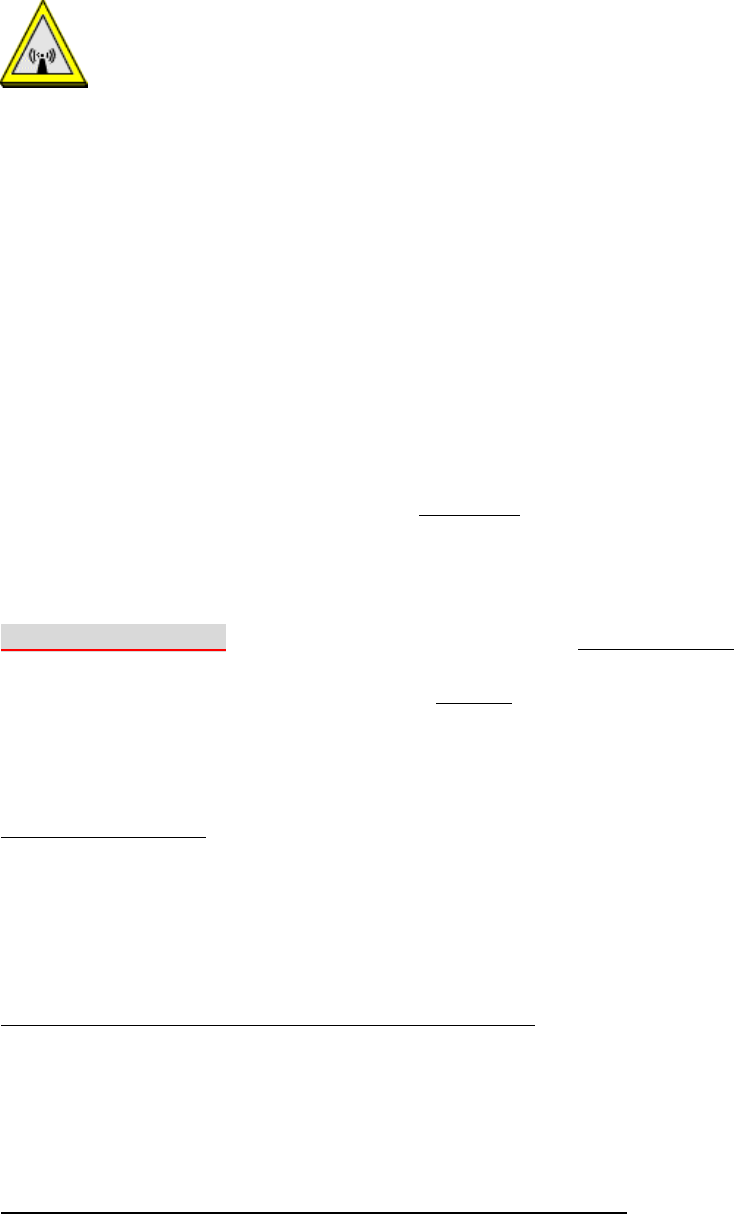Handlink Technologies HL-11G Mini PCI Module User Manual
Handlink Technologies Inc. Mini PCI Module
User Manual
1
HL-11G
11g mini-PCI Module
User’s Manual

2
FCC Statement
Warning: Changes or modifications to this unit not expressly approved by the party responsible for
compliance could void the user authority to operate the equipment.
This device complies with Part 15 of the FCC Rules. Operation is subject to the following two
conditions:
(1) this device may not cause harmful interference, and
(2) this device must accept any interference received, including interference that may cause undesired
operation.
NOTE: This equipment has been tested and found to comply with the limits for a Class B digital
device, pursuant to Part 15 of the FCC Rules. These limits are designed to provide reasonable
protection against harmful interference in a residential installation. This equipment generates, uses
and can radiate radio frequency energy and, if not installed and used in accordance with the instructions,
may cause harmful interference to radio communications.
However, there is no guarantee that interference will not occur in a particular installation. If this
equipment does cause harmful interference to radio or television reception, which can be determined by
turning the equipment off and on, the user is encouraged to try to correct the interference by one or
more of the following measures:
Reorient or relocate the receiving antenna.
Increase the separation between the equipment and receiver.
Connect the equipment into an outlet on a circuit different from that to which the receiver is
needed.
Consult the dealer or an experienced radio/TV technician for help.
Service Center in U.S.A
Company Name : ZyXEL Communications, INC. USA
Company Address: 1650 E. Miraloma Ave. Placentia, CA 92870
Tel: (714)632-0858

3
CAUTION:
1. To comply with FCC RF exposure compliance requirements, a separation distance of at least 20
cm must be maintained between the antenna of this device and all persons.
2. This Transmitter must not be co-located or operating in conjunction with any other antenna or
transmitter
This device is intended only for OEM integrators under the following conditions:
1) The antenna must be installed such that 20 cm is maintained between the antenna and users.
For laptop installations, the antenna must be installed to ensure that the proper spacing is
maintained in the event the users places the device in their lap during use (i.e. positioning of
antennas must be placed in the upper portion of the LCD panel only to ensure 20 cm will be
maintained if the user places the device in their lap for use) and
2) The transmitter module may not be co-located with any other transmitter or antenna. As long as
the 2 conditions above are met, further transmitter testing will not be required. However, the
OEM integrator is still responsible for testing their end-product for any additional compliance
requirements required with this module installed (for example, digital device emissions, PC
peripheral requirements, etc.).
IMPORTANT NOTE: In the event that these conditions can not be met (for example certain
laptop configurations or co-location with another transmitter), then the FCC authorization is no
longer considered valid and the FCC ID can not be used on the final product. In these
circumstances, the OEM integrator will be responsible for re-evaluating the end product (including
the transmitter) and obtaining a separate FCC authorization.
End Product Labeling
This transmitter module is authorized only for use in devices where the antenna may be installed
such that 20 cm may be maintained between the antenna and users (for example access points,
routers, wireless ASDL modems, certain laptop configurations, and similar equipment). The final
end product must be labeled in a visible area with the following: "Contains TX FCC ID:
TWS-HL-11G".
RF Exposure Manual Information That Must be Included
The users manual for end users must include the following information in a prominent location
"IMPORTANT NOTE: To comply with FCC RF exposure compliance requirements, the antenna
used for this transmitter must be installed to provide a separation distance of at least 20 cm from all
persons and must not be co-located or operating in conjunction with any other antenna or
transmitter."
Additional Information That Must be Provided to OEM Integrators
The end user should NOT be provided any instructions on how to remove or install the device.

- 1 -
Introduction
The HL-11G Wireless module This module is the wireless networking device based on
802.11g technology and compatible for interoperability with existing 802.11b devices. This
device provides 54Mbps transfer rate in wireless network.
HL-11G is designed for Printer Server series, IP Camera series and Internet Video Server
gives you wireless access the web and network resource without the wire.
HL-11G provides high-speed access to network resources and has built-in 64-bit and 128
bit of WEP (Wired Equivalent Privacy) data encryption. With Direct Spread Spectrum
Signaling (DSSS), domain access control, WEP encryption and group security, the modules
will safeguard all your wireless data transmissions from your nosy neighbors.
HL-11G allows you to take full advantage of your devices mobility with access to real-time
information and online services anytime and anywhere.
1. Feature
♦ Design for IP Camera series.
♦ Compatible with IEEE 802.11g and 802.11b Standard for 2.4GHz Wireless .
♦ Works with All Existing Network Infrastructure.
♦ Compatible with WiFi Wireless Products and Services.
♦ Capable of up to 128-Bit WEP Encryption.
♦ Freedom to Roam While staying Connected
♦ Up to 54 Mbps High-Speed Transfer Rate.
♦ Two I-PEX Connectors for External Antenna
♦ Support Antenna diversity for Better Sensitivity.
♦ Lower Power Consumption.

- 2 -
2. Specification
Wireless Specifications
Standard IEEE 802.11g, IEEE802.11b
Chipset RT2561T+RT2527
Interface miniPCI interface
Connector Two I-PEX connector
LED N/A
Frequency Range 2.412GHz-2.4835GHz
2.412-2.462 GHz(North America)
2.412-2.484 GHz(Japan)
2.412-2.472 GHz(Europe ETSI)
2.457-2.462 GHz(Spain)
2.457-2.472 GHz(France)
Number of Selectable
Channels
USA, Canada: 11 channels
Europe: 13 channels
Japan : 14 channels
Data rate 802.11g: 54, 48, 36, 24, 18, 12, 9, 6 Mbps
802.11b:1,2,5.5, 11 Mbps
Modulation Technique 802.11g: Orthogonal Frequency Division
Multiplexing (64QAM, 16QAM, QPSK, BPSK)
802.11b:Direct Sequence Spread Spectrum (CCK,
DQPSK, DBPSK)
Security 0/64/128 bit WEP
Media Access Protocol CSMA/CA(Collision Avoidance) with optional ACK
Output Power 20.96 dBm
Range 802.11b > 300 m
802.11g > 150 m
Sensitivity 802.11b > -82 dBm
802.11g > -69 dBm
3. Hardware Installation
The following sections in this chapter describe how to install HL-11G Module
3.1. Installation Overview
HL-11G wireless module is design for Wireless Gateway only.

- 3 -
3.2. Safety Recommendations
The safety guidelines are as follows:
λ Keep the board area clear and dust-free before, during, and after installation.
λ Keep tools away from walk areas where you and others could fall over them.
λ Do not wear loose clothing or jewelry, such as earrings, bracelets, or chains,
that could get caught in the board.
λ Wear safety glasses if you are working under any conditions that might be
hazardous to your eyes.
λ Do not perform any action that creates a potential hazard to people or makes
the equipment unsafe.
λ Never attempt to lift an object that is too heavy for one person to handle.
3.3. Maintaining Safety with Electricity
Warning: Before working on a board or working near power supplies,
unplug the power cord on AC units; on DC units, disconnect the power at
the circuit breaker.
Follow these guidelines when working on equipment powered by electricity:
λ Do not work alone if potentially hazardous conditions exist anywhere in your
work space.
λ Never assume that power is disconnected from a circuit; always check the
circuit.
extension cables, frayed power cords, and missing safety grounds.
λ If an electrical accident occurs, proceed as follows:
– Use caution; do not become a victim yourself.
– Disconnect power from the system.
– If possible, send another person to get medical aid. Otherwise, assess the
condition of the victim and then call for help.
– Determine if the person needs rescue breathing or external cardiac
compressions; then take appropriate action.
- 4 -
3.4. Installing a HL-11G
λ Remove the HL-11G module from its protective packaging.
λ Avoiding Electrostatic Discharge
Before you install the HL-11G module, ground yourself by touching a
piece of metal to avoid electrostatic discharge (ESD). You should also
take the following precautions to prevent damage to the HL-11G
module:
λ Keep the HL-11G module in its antistatic-shielded bag until you
are ready to install it.
λ Handle the HL-11G module by its edges.
λ Ensure the connector is connected to above Model’s board tightly.